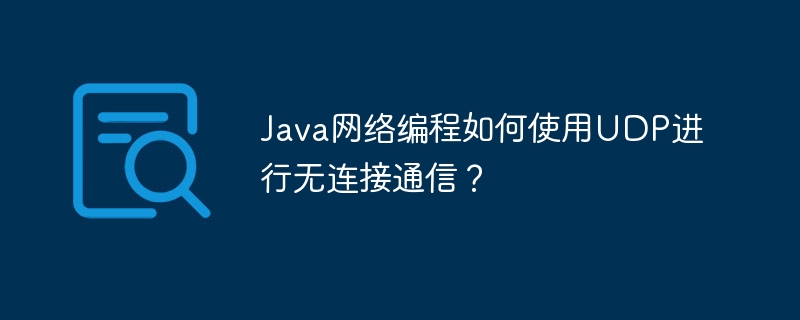Home >Java >javaTutorial >How does Java network programming use UDP for connectionless communication?
How does Java network programming use UDP for connectionless communication?
- WBOYWBOYWBOYWBOYWBOYWBOYWBOYWBOYWBOYWBOYWBOYWBOYWBOriginal
- 2024-04-15 12:51:01680browse
UDP (User Datagram Protocol) is a lightweight connectionless network protocol commonly used in time-sensitive applications. It allows applications to send and receive data without establishing a TCP connection. Sample Java code can be used to create a UDP server and client, with the server listening for incoming datagrams and responding, and the client sending messages and receiving responses. This code can be used to build real-world use cases such as chat applications or data collection systems.

Java Network Programming: Connectionless Communication Using UDP
Introduction
UDP (User Datagram Protocol) is a lightweight, connectionless network protocol commonly used in time-sensitive applications. It allows applications to send and receive data without establishing a TCP connection.
Usage
The following is an example of creating a UDP server and client using Java:
Server code:
import java.net.*;
public class UDPServer {
public static void main(String[] args) throws Exception {
// 创建一个DatagramSocket,监听6789端口
DatagramSocket serverSocket = new DatagramSocket(6789);
// 持续监听传入的数据报
while (true) {
// 创建一个数据报对象来接收数据
DatagramPacket receivePacket = new DatagramPacket(new byte[1024], 1024);
// 接收数据报
serverSocket.receive(receivePacket);
// 获取客户端地址和端口
InetAddress clientAddress = receivePacket.getAddress();
int clientPort = receivePacket.getPort();
// 将数据报转换为字符串
String message = new String(receivePacket.getData(), 0, receivePacket.getLength());
System.out.println("收到来自 " + clientAddress + ":" + clientPort + " 的消息:" + message);
// 创建一个数据报对象来响应客户端
DatagramPacket responsePacket = new DatagramPacket(
("响应:" + message).getBytes(),
("响应:" + message).getBytes().length,
clientAddress,
clientPort
);
// 发送响应
serverSocket.send(responsePacket);
}
// 关闭服务器套接字
serverSocket.close();
}
}Client code:
import java.net.*;
public class UDPClient {
public static void main(String[] args) throws Exception {
// 创建一个DatagramSocket
DatagramSocket clientSocket = new DatagramSocket();
// 获取要发送的消息
String message = "你好,世界!";
// 将消息转换为字节数组
byte[] messageBytes = message.getBytes();
// 创建一个数据报对象,将消息发送到服务器的6789端口
DatagramPacket sendPacket = new DatagramPacket(
messageBytes,
messageBytes.length,
InetAddress.getByName("localhost"), // 服务器地址
6789 // 服务器端口
);
// 发送数据报
clientSocket.send(sendPacket);
// 创建一个数据报对象来接收服务器的响应
DatagramPacket receivePacket = new DatagramPacket(new byte[1024], 1024);
// 接收响应
clientSocket.receive(receivePacket);
// 将响应转换为字符串
String response = new String(receivePacket.getData(), 0, receivePacket.getLength());
// 打印响应
System.out.println("收到服务器的响应:" + response);
// 关闭客户端套接字
clientSocket.close();
}
}Practical case
This code can be used to build a simple chat application or data collection system. For example, you can use client code to send a message to the server, and then use server code to respond to the message.
The above is the detailed content of How does Java network programming use UDP for connectionless communication?. For more information, please follow other related articles on the PHP Chinese website!

